How to defy the Light Bulb ban.




240V GLS bulbs in clear and pearl with E27 and B22 bases as used
in Australia have now become a prohibited import. Aren't they just a gorgeous
and graceful work of art? Yet, the ill informed are convinced they will
destroy the planet.
Of concern to many people; particularly
those who haven't been brainwashed by the trendy eco nazis, is that incandescent
lamps which have been such an important part of our civilisation are being
banned by various governments. Because many people prefer incandescent
lamps to other light sources, they have continued to be popular, even though
CFL's are a huge proportion of the lighting market. Here, we see
the population deciding what kind of light bulbs are best for their use.
But because what the population wants is not what the government, pressured
by lobby groups, wants, incandescent lamps are now a restricted import
in Australia. Paradoxically, we are made to feel guilty about using incandescent
bulbs, but not about plasma displays, air conditioners, or four wheel drive
vehicles..
In this article I describe methods to
continue the use of incandescent lamps with what is currently available.
1. Problems with CFL's
(Compact Fluorescent Lamps).
-
Ugliness - no more need to be said here.
-
Light quality is not the same as incandescent;
in fact it's quite nauseating to look at; especially the bright "daylight"
types with a colour temperature of around 5000-6000K.
-
Physical dimensions. Not the same as incandescent
bulbs. This can be a problem where the light fitting relies on the shape
and size of the envelope.
-
Unable to be used in hot environments (e.g.
enclosed light fittings) without shortening their life. The electrolytic
capacitors dry out and switching transistors overheat.
-
Unable to be used in damp environments. Moisture
condensing on the PCB causes leakage and if the PCB doesn't carbonise first,
the leakage current will cause a chain reaction of blown fragile semiconductors.
-
Dim and slow startup in cold environments.
Full brilliance is obtained after a few minutes operation. Not convenient
where the lamp is only needed for a few seconds at a time.
-
Cannot be rapidly turned on and off. No more
flashing lights outside the pizza shop.
-
Radio Frequency Interference. The inverter
circuitry radiates harmonics into the Medium Wave band. Some lamps are
worse than others in this regard. Of course, there are plans to shut down
Medium Wave AM transmitters so that fixes that.
-
Distortion of the mains supply. This is a
serious problem, and is getting worse. Like other switchmode supplies,
CFL's rectify and filter the mains supply thus providing 340V DC to run
the high frequency inverter. Towards the peak of the mains voltage cycle
is where the filter capacitor charges and draws current. As a result, the
mains voltage is no longer sinusoidal. The resulting harmonics also cause
losses in the transmission system.
-
The lamps are not dimmable, unless you want
to pay for a very expensive and not easily obtainable one.
-
Running the lamps at reduced voltage destroys
them. Unlike a filament lamp which is happy with 240V RMS (or less)
of any shaped waveform, the CFL needs a 240V sine wave to provide the 340V
peak. If this is reduced, the switching transistors inside the lamp do
not saturate due to reduced drive. Thus they overheat. This means CFL's
shouldn't be run off a square wave inverter with only 240V peak output.
-
Where a two wire sensor, touch switch etc.,
is used to switch the lamp, insufficient current flows to power the
sensor.
-
Phantom flashing because of leakage current.
The capacitance in the wiring between the switch on the wall and socket
on the ceiling is often enough to cause the lamp's filter capacitor to
slowly charge allowing the lamp to function as a relaxation oscillator.
This could easily be fixed with a bleed resistor or shunt capacitor across
the supply.
-
Unable to deal with voltage spikes. Instant
death to the fragile semiconductors is what happens if the mains voltage
should be momentarily exceeded, whereas the incandescent carries on so
long as the spike didn't have time to overheat the filament. Semiconductors
die faster than a filament heats up.
-
The waste of materials and electronic components.
The nasty chemicals do not exist with incandescent bulbs.
-
Ultra Violet light output. Mercury vapour
when ionised such as in a fluorescent tube radiates UV light. Most is absorbed
by the phosphor and glass, but not all. Have you noticed that light coloured
plastic objects in a room lit by fluorescent light tend to become discoloured?
For example, a white telephone becomes a sickly yellow colour after a while.
Incandescent lamps do not radiate any damaging kind of light.
2. What is banned
GLS light bulbs are the main item affected.
These are the standard 240V household light bulbs that come in 25,40,75,
and 100W. Interestingly, the ban applies to lamps of this type only with
a voltage of 220 or more. GLS bulbs of 150W and above are still permitted,
as are pilot lamp, fancy round, and candle shapes of 25W or less. Coloured
GLS bulbs are also exempt.
The importation was stopped in February
2009, and a retail ban came into force in November 2009. In 2010,
a greater range of bulbs was banned, and year by year this continues until
the government has eradicated any form of filament lighting. The zeal and
determination to eliminate incandescent lamps is unseen in any other government
projects that would actually be useful.
On the customs website is a pictorial
list of banned bulbs. Note that incandescent lamps are grouped alongside
things like knives, daggers, hazardous waste, etc. I got no proper answer
when I enquired to the associated email address with some detailed questions.
I also could not get an answer as to what if someone from overseas brings
in a couple of light bulbs in their luggage. Would they get the $110,000
fine?
This list shows the timetable of banning.
One of the complying factors must be the acceptable lamps must have a 2000
hour life. Why? A cynical person would think that this is a way to ban
GLS light bulbs even if they were more efficient. As we know, typical GLS
bulbs have a life of 1000 hours, so even if we made them more efficient,
the government is intent on banning them, no matter what, just because
they are incandescent. Show a light bulb to a greenie and they'll act like
they've just met the Devil. Then you'll get a speech about how you don't
care about the Earth, etc. In fact there seems to be some kind of religious
zealotry about this, like one would expect from one of those religious
fanatics with deep set eyes and who froths at the mouth in a convulsing
rage as they insist their view is the correct one.
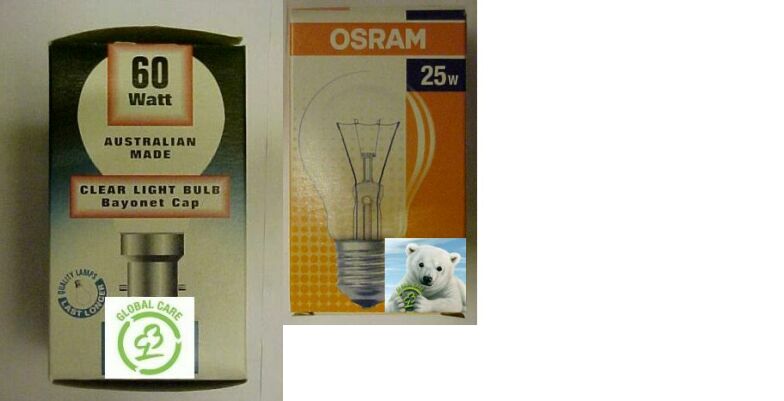
One way to make incandescent bulbs acceptable would have been to
put politically correct icons on the packaging.
3. Hoarding Bulbs.
Most important, and it seems many people
have missed the boat, so to speak. In a place like Australia you wouldn't
really think they would take away light bulbs for sale would you? Unfortunately,
it did happen, the import ban did come into force in February 2009, and
people were being met with empty shelves in the shops. I saw this coming
well before and hoarded enough bulbs for my own use, but for others who
later become aware of the situation there is some hope and ways to deal
with the situation.
The new law (note that like most new laws,
this one is yet another freedom taken away) stated that retailers had until
November 2009 to sell off remaining stock. Some supermarkets (particularly
smaller independent ones) still had bulbs which were being sold off at
a reduced price at this time. Mostly these were E27 (Edison Screw) base,
as these are less used in Australia.
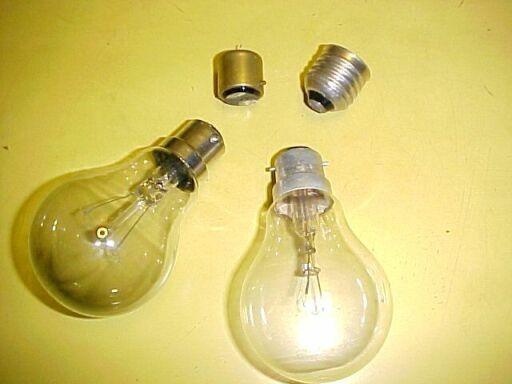
Blown light bulbs are worth keeping for their bases to make adaptors
or to convert bulbs from one base to another. In their own right they are
a beautiful object that those with an artistic talent could use to make
decorations. Why not hang them from your Christmas tree? Burnt out coloured
ones would be ideal for this.
Even though most light sockets in Australia
are B22 (Bayonet Cap), it is important to still collect E27 bulbs as will
be explained later. Whilst the bulbs might not always be of your favourite
wattage, you still need to hoard them. There are ways to get the brightness
you prefer, which again will be explained.
Not yet banned, as of 2014, are Candle,
Fancy Round, and Appliance Lamps of 40W or less. While these are more expensive
than GLS bulbs, they are are still one option. So, if you've missed out
on GLS bulbs, you have a second chance to hoard these.
Oven lamps are available up to 25W but
are only available in E27 base. These and other appliance lamps will be
available for somewhat longer. Having said that, there is still this insatiable
drive to eliminate any kind of incandescent bulb no matter what, and you
can be sure they will be eradicated.
However, where the shape and size of bulb
is important (there were some old table lamps where the shade actually
clipped onto the bulb) you still need GLS.
4. Changing the base.
So, you've got a carton of E27 bulbs because
they were cheap (and that's all that was left), or you've decided to use
screw base oven bulbs to light your house because they haven't been banned
yet. Not a problem! There's several ways to deal with this:
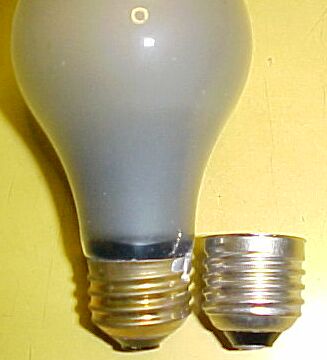
The difference between the U.S. Medium Screw (E26) base (left),
and the Australian/European E27 (right). They are interchangeable but the
U.S bulb may not always make contact in an E27 socket. Incidentally, the
bulb shown here is 12V 50W, as used on my solar/wind home lighting
plant.
-
Buy or make an adaptor. These are widely available
on ebay. It is also easy to make one up yourself. Simply connect an Edison
Screw light socket to a bayonet plug via a short length of flex. E27 light
sockets are available from electrical wholesalers under Clipsal part number
501ES. If you prefer a batten (surface mount) socket, use a Clipsal 530ES.
To connect to your existing bayonet socket, you'll need the Clipsal 466
bayonet plug. You can also remove the base of a burnt out B22 bulb and
use that instead. If the Clipsal E27 sockets are not to your liking, plenty
of E26 sockets are available from the U.S on the internet. What's the difference
between E26 and E27 you may ask? It's the length of the base. The European
E27 base is slightly longer than the E26. What this means is that an Aussie
or European bulb screwed into a U.S socket will have more of the base exposed.
If the possible shock hazard worries you simply wrap the exposed part of
the base with insulating tape before screwing it in. Where U.S. bulbs are
screwed into Australian/European E27 sockets there is a chance that the
bottom of the base will not make contact. If so, simply bend the contact
in the bottom of the socket up slightly. If this isn't possible then add
a slight lump of solder to the bottom contact of the bulb base.
-
Change the light sockets to E26 or E27. A
difficulty that can arise here is where lampshades are used. The skirt
size on the Clipsal sockets is larger than the standard B22 socket, so
the hole in the centre of the lampshade has to be enlarged. U.S lamp sockets
do not have removable skirts. Most of the world uses ES. It also allows
ease of use with 25W oven bulbs.
-
Actually change the base. If you're patient
and careful this can be done. For this reason, do not throw away burnt
out light bulbs...they are a source of donor bases! The first and easiest
step is to get the base off a blown light bulb. After breaking away the
glass you'll need to chip and break away at most of the cement inside the
base. Also, remove the solder and remaining stem wires. Next, you need
to prepare the E27 bulb. Incidentally, if you find any E27's with a loose
base, don't glue it back on, convert it to B22. Getting the base off a
bulb is somewhat difficult. I haven't found anything that just dissolves
the cement. The best option is to carefully cut it with a fine hacksaw
a few mm away from the glass. Hold the base only when doing this, not the
glass! Desolder the wires first so when it comes free they won't get broken.
Now, you'll have to connect the wires to the bayonet base, possibly extending
them. Glue the BC base to what's left of the ES base with epoxy. Then solder
the wires to the BC contacts. If you've been lucky and had a bulb with
a loose base to start with, attaching the new B22 base is easier, and the
completed job makes it hard to tell anything was changed.
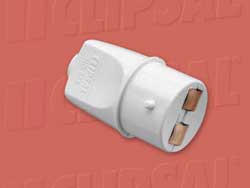
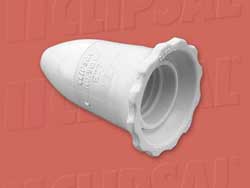
This bayonet plug and E27 socket allow you to make adaptors to use
screw base bulbs in bayonet sockets.
5. Getting the right
brightness.
Your hoardings may not have have left
you with your preferred wattage lamps. It seems that 60W BC is probably
the most popular GLS lamp in Australia, probably followed by 100W. So,
these are the hardest to come by. Not to worry; we can use others to obtain
the required light output.
-
You need more light but have only low wattage
bulbs. Once upon a time you could get bayonet double adaptors. These were
primarily intended for running appliances off light sockets before power
points became commonplace in houses. They still turn up at swap meets,
garage sales etc. By using one of these you can install two low wattage
bulbs to bring up the light level. For example, a couple of 15W pilot lights
could be used to replace one 25W bulb, and so on. Of course you can make
your own double (or triple, etc.) adaptor with a bayonet plug and as many
lamp sockets as required. This way, we can light a large room with candle,
fancy round, or oven bulbs. The catch to this scheme is where the light
fitting is enclosed and there isn't room for the extra bulbs and sockets.
However, incandescent lamps are an object of artistic beauty and there
is no shame in having them fully exposed.
-
You've only got cartons of 100W bulbs or lots
of 300W bulbs and don't want such brightness. This is easily dealt with
by using a dimmer or other voltage dropping device. Alternatively, try
connecting bulbs in series; not necessarily the same wattage either. See
what combinations of brightness you can come up using this scheme. A quick
and simple voltage reducer can be had by connecting an ordinary rectifier
diode in series with the bulb; this will drop the RMS voltage down to 170V.
However, flicker may be present dependent on the filament thickness due
to the lamp flickering at 50 times a second instead of 100. A limitation
with dimming bulbs is that the colour temperature of the lamp is reduced
and becomes much more red.
6. Low voltage bulbs.
It's obvious what the agenda of government
control is when one looks as the prohibition list and sees that the banned
bulbs are those which are rated for 220V and above. We can clearly see
the motive is to prevent sales of bulbs that will just plug straight into
Australian 240V light sockets and are thus of most convenience for Australians
who prefer to choose the light source in their private homes. Although
220V bulbs are not the norm here, they will work but just with a reduced
life (a rough rule is a 5% increase in voltage halves the life). Obviously,
the clowns who came up with the law are clever enough to have worked that
one out.
What has not been banned from sale or
importation is lower voltage bulbs. And here we actually see there's a
lot of flexibility.
-
Low voltage GLS lamps. In Australia it has
been possible, and was until recently possible, to buy GLS bulbs in 12,
24,32, 50 and 120V with both B22 and E27 bases. These came about as a result
of the prevalence of home lighting plants in rural areas until the 1950's.
They've also been used in boats(12V), caravans(6 & 12V), trains (32V),
telephone exchanges and emergency lighting (50V) and more recently with
solar and wind lighting plants (12&24V). With the closure of the ELMA
factory in Newcastle, these lamps are now imported from China, mainly by
Crompton. Unfortunately, they are not cheap, and Crompton have recently
discontinued them. The 12V GLS lamps I use on my home lighting plant typically
cost about $3.50-$7.00 each. However, they last an extremely long time.
E26 GLS lamps in 12V are less than half the price from the U.S, and I imported
a large supply of them a few years ago when I set up my home lighting plant.
The point of this is to say that you can still use your existing light
fittings with these bulbs. Simply power the light fitting from a suitable
transformer. An option if you're serious about using these bulbs is to
run two light circuits in your house as I've done; one at the lower voltage
and the original 240V circuit for fluorescent lamps.
-
120V bulbs. These have been made and sold
in Australia in the past. They were used in some trains, home lighting
plants, and emergency lighting systems. While you can buy them here through
electrical wholesalers, they are not cheap as I've mentioned above. Much
cheaper to buy from the U.S where they're a standard supermarket item,
although with an E26 base only. Keep in mind that they won't be available
forever but you'll have a bit longer to stock up on them. Use them in series
pairs, or off a transformer. Of course, when using in series, you must
use ones of the same wattage. Again, one could convert the house lighting
circuit to 120V fed from a transformer and change the light sockets to
E26 types.
-
12V car/boat/caravan bulbs. For the diehard
incandescent lamp user, these are yet another option. Brake lights and
indicator bulbs are typically 21W. The bayonet base of these is smaller
(19mm) so it need not be removed if fitting a B22 base. Most would use
a transformer, but connecting 20 in series is an option. Keep in mind that
if doing this, the lamp sockets will need to be insulated for 240V. Also,
remember if one burns out, 240V will be present at the socket terminals.
The SBC double contact base used with caravan and boat lamps is the same
as that used for their 240V counterparts. Most 240V SBC lamps are used
in chandeliers and vanity lights (lights around mirrors). B22 to SBC adaptors
are available on eBay.
7. Extending lamp life.
Having secured your precious bulbs, you'll
want them to last as long as possible. Typically, the lamp life of a 240V
light bulb is quoted at 1000 hours. It's also a known characteristic that
a slight reduction in voltage gives an exponential increase in life.
Also, reducing the switch on surge will extend lamp life.
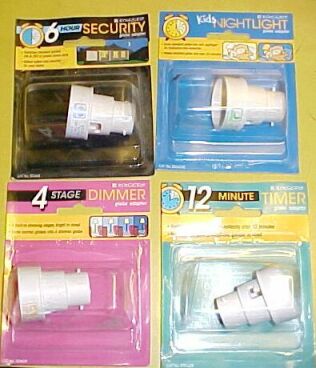
These adaptors from Ring Grip all have a soft start feature and
are worth using for that purpose alone. Because they are not suitable for
CFL's these were on sale very cheap.
-
Use a dimmer, or other voltage dropper. As
an example, two Australian made Crompton 40W bulbs in my living room reading
lamp were in use since 1987 and only failed in 2011. This lamp is plugged
into a dimmer which is never turned up past about 80%. The difference in
brightness is only discernable when making a comparison; the colour temperature
is not noticeably reduced. A diode used as a dimmer, described previously,
is effective and simple, providing flicker is not bothersome. One way to
remove flicker is to have two bulbs in the fitting; one fed on the positive
part of the mains cycle and the other fed on the negative. Although the
individual bulbs may still be seen to flicker, the combined light output
won't.
-
Look for higher voltage bulbs. When bulbs
were still manufactured here, you could buy them in 260V, even from some
hardware stores. These would last several years. In fact, the glass
would blacken well before the filaments burnt out.
-
Use higher wattage lamps with a dimmer/dropper
to give the same brightness as a low wattage bulb. As mentioned previously,
if you don't mind a reduction in colour temperature, this is a good way
to get long life. For example,if you normally use a 40W bulb in a light
fitting, change it to a 60W and reduce the supply voltage to get the same
brightness. You'll get the same light but the bulb will last so much longer.
If colour temperature is of concern, use the next highest wattage bulb
to minimise the effect. A 300W bulb dimmed to give 40W of light will be
much redder than a 60W bulb dimmed for the same amount of light.
-
Surge suppression. Ring Grip used to sell
various adaptors to fit between a light bulb and bayonet socket which would
allow the bulb to be dimmed, used as an automatic night light, or as a
timer. The "programming" of the adaptor is done by switching the light
on and off in a certain pattern. Very convenient and they work well, despite
creating very bad RFI. The one thing in common is that all these adaptors
have a soft start feature; i.e. the RMS voltage to the bulb rises gradually
after switch on. Prior to the adaptors, Ring Grip sold light bulbs with
the circuitry inside the base. But, at a cost of $25 each they didn't sell.
So, when Bunnings started offloading them for about 10 cents each, along
with the adaptors, I bought a large quantity. I use one of the 30 minute
timer adaptors for my 25W B22 laundry light. As the light is never needed
for more than a few minutes, the timing function goes unnoticed, but the
soft start is always there. It is also possible to build a soft start circuit,
with several designs appearing in electronics magazines over the years.
They were particularly popular with projector lamps. For the 300W GES base
lamp in my garage, a resistor is in series with lamp which then is shorted
out by means of a 555 and a relay after a few seconds. A suitable thermistor
can be used for the same effect.
-
Avoid vibration, especially when the bulb
is on. Lamp sockets with switches on them are best not used; turn the lamp
off with an in line switch or at the power point. Portable lead lamps will
give very short life to bulbs used in them; this is one place I do recommend
CFL's or LED bulbs.
8. Repairing light bulbs.
Providing the fuses haven't blown or the
filament hasn't broken in more than one place, it is usually possible to
get several more months out of a bulb. With lower voltage bulbs the repair
is even more effective; the number plate light bulb for my modern car failed
in 1997. It is still working to this day after being "repaired".
What has to be done is to weld the two
ends of the filament together. With low voltage bulbs this is as simple
as applying normal voltage and tapping on the bulb in the right direction
so the filament touches together. When the ends connect, the surge current
will weld them together in a crude sort of way.
With 240V bulbs because the filament is
long and thin, it's liable to burn out with the surge current. So, the
key to success here is to use a lower voltage; enough to weld but not enough
to blow. I've had good success with around 100-150V. Hold the bulb at the
right angle so that then filament ends can be brought together. Sometimes
if the filament has sagged during the bulb's life there isn't quite enough
length. In this case, you need to free the longer portion of filament from
its nearest filament support. This can be done by tapping the bulb at the
right angle. This will give you a useful extra length of filament and can
sometimes help if a small portion of filament has broken off altogether.
Of course, with a shortened filament, it really should be run at a lesser
voltage.
Make sure the bulb is away from any vibration
as the filament is weakened not only by the join, but overall by metal
fatigue and the fact some of the filament has evaporated over its life.
As an example of results that can be obtained;
I had a 60W no name bulb that lasted a year in a table lamp. When it failed,
I rejoined the filament and got another four months out of it. By the time
it failed again the filament had broken in more than one place, and could
not be repaired. The glass was so black it was giving out about the same
light as a 25W bulb.
9. Antique reproduction
bulbs.
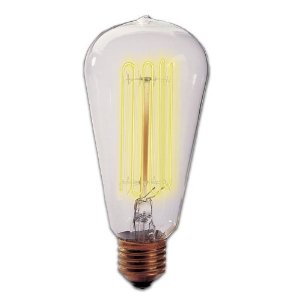
These are not in the banned list, so are
available in Australia from Bunnings and various lighting shops. They are
really intended to be a decorative item. Here you will pay about $20 each
for them, although the price is dropping. To avoid paying the "Australia
Tax", it's cheaper to buy direct from the U.S at about half the price,
if you can get a good deal on the postage. However, make sure of the voltage.
While some U.S sellers can supply 240V bulbs, not all do. If you buy 120V
bulbs you will need a transformer, or run two of the same wattage in series.
Most are made under the "Ferrowatt" brand. I bought some 240V B22 ones
from a U.S. ebay seller and found them to be well made. The exhaust tip
on the bulb is just for appearance; the bulb construction is otherwise
modern. The ones I bought have a squirrel cage filament as per the illustration
above, but are available with other vintage styles. Interestingly, unlike
the original squirrel cage bulbs, the reproductions actually have a coiled
filament. This is visible upon looking closely. The bulbs certainly work,
but are not really practical in many situations. For a 60W bulb, the light
given out is about the same as a modern 25W bulb, and the colour temperature
is much lower. So, from an efficiency point of view they are quite poor.
On the plus side they are claimed to last 2000hrs.
10. Halogen GLS bulbs
- Incandescent bulbs are still available.
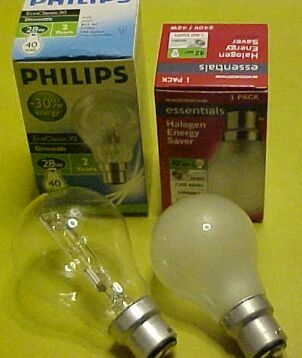
These resemble and perform the same as a standard incandescent bulb.
These reappeared in 2009 as a permitted
substitute for the standard incandescent bulb. I say "reappeared", because
these bulbs have been around since 2002, made by Osram under the "Halolux"
name. Externally, they are identical to the standard bulb, but contain
a halogen filled capsule with the filament inside that.
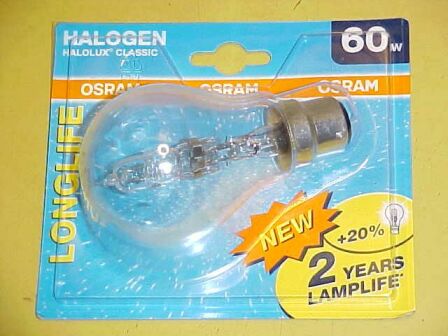
Bought in 2002, this bulb is merely claimed to have long life, with
minimal reference to improved efficiency.
What I find surprising is these bulbs are
readily available at every supermarket, yet many people think you can't
buy incandescent bulbs any more. These are incandescent!
The performance is virtually indistinguishable
from the normal argon filled incandescent bulb.
The difference is that the halogen atmosphere
allows the filament to run hotter (and thus more efficiently). The tungsten
particles are reabsorbed in the filament instead of on the glass walls.
This is why halogen bulbs do not darken as they age. The UV problem is
reduced by virtue of the outer glass bulb.
This can in fact be broken and the bulb
will still work, but the UV output will increase.
It is now possible to buy the halogen
GLS bulbs for about $2 each. This equates to much the same price as the
standard bulb when one takes into account the 2000hr life.
For those who didn't hoard first time
around, I strongly recommend you start hoarding these. While they currently
meet MEPS specifications, remember there is an underlying drive to eliminate
filament lamps and you can be sure these will eventually be targeted. It
doesn't take long to build up a collection if you just buy a couple each
time you go shopping.
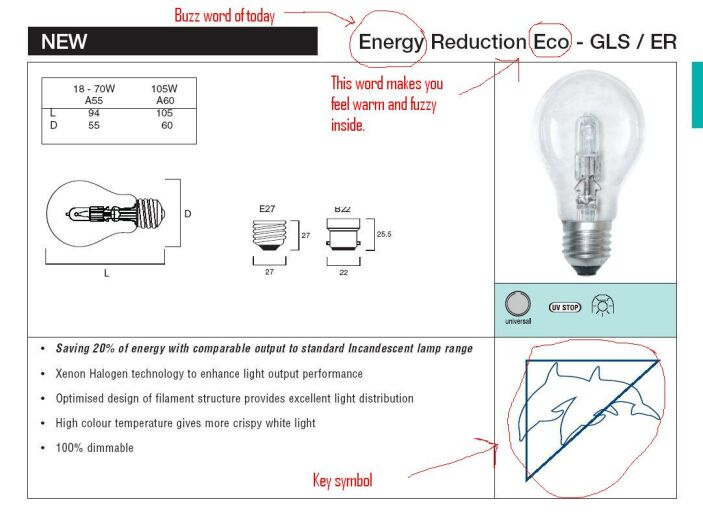
All the well known brands are now selling halogen GLS bulbs. This
one is from Sylvania.
The obvious choice is to use these halogen
GLS bulbs where all the characteristics of the argon filled filament bulbs
are required. Externally, they are identical with the same light quality,
and fitted with a tungsten filament, have the same resistive loading characteristics.
Of course, as such they are fully dimmer compatible and do not care about
waveform or frequency. For those who didn't hoard the first time round,
you have a second chance with these.
11. Ebay.
Ordinary 240V GLS incandescent bulbs are
obtainable on ebay from Hong Kong and UK suppliers. I would be interested
to know the results of someone in Australia buying them and if there were
any problems with customs. Likewise, purchasing from New Zealand is an
option, where the government did implement the ban but then overturned
it.
12. LED bulbs.
Since about 2012, there has been a huge
increase in the availability of LED bulbs, which are available in all the
styles of domestic bulbs; everything from candle to PAR38 floodlights.
Prices vary considerably from around $10
to $25. One type I have tried, a Click GLS shaped bulb is actually very
good.
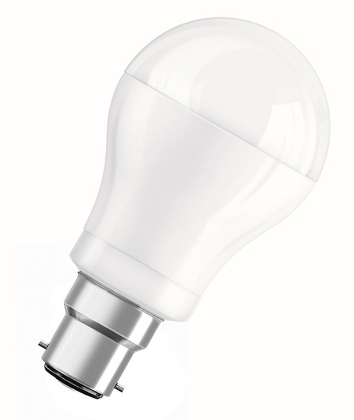
The colour temperature was very close
to that of an incandescent lamp. In fact, it was not actually obvious that
it was a LED bulb. It was far superior to any CFL.
However, there is a lot of variation in
what's available. One limitation of many LED bulbs is the light appears
only at the end of the bulb and not the sides. Also, where the LED is powered
via a switchmode supply, some RFI might be evident. On ebay, LED bulbs
are also available with B22 and E26/E27 bases in low voltage.
Unfortunately, although LED lighting has
its place, it will be the final nail in the coffin for incandescent lighting.
Already, it is becoming standard for automotive lighting. Portable lighting,
like torches and camping lights is now virtually all LED based. How often
do you see a torch for sale with an incandescent bulb now? Flood lamps
are rapidly moving away from halogen to LED bulbs.
13. LED filament bulbs.
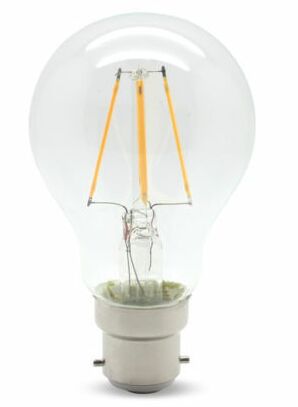
For non incandescent lamps, these are
the perfect substitute. The light quality is for all practical purposes
the same as an incandescent bulb both in appearance and colour. Power consumption
is roughly one tenth of the incandescent counterpart for the same amount
of light. Cosmetically, the bulbs are identical in terms of having a glass
bulb and "filaments" inside, and when illuminated, it is very hard to tell
they're LED. Various bulb styles are available such as candle and 1920's
squirrel cage bulbs, as well as the normal GLS. The better designed bulbs
have a fully glass envelope (as shown above), while others are part plastic
(to get the extra room for their control gear). Like other LED bulbs, warm
white or cool white types are available. Obviously, one chooses warm white
to get the same colour as an incandescent lamp.
The filaments are comprised of lots of
individual LED's and thus have a relatively high voltage drop; something
like 60V. The power supply is built into the base and is either a switchmode
converter or a capacitive dropper. However, this is where problems can
arise. The switchmode converters are not bothered by supply waveform or
frequency, as the mains is rectified and filtered to DC. So, there should
be no problems with operating this type off an inverter. Capacitive dropper
types are obviously frequency dependent because of the reactance of the
series capacitor. Thus, operating such a lamp off a frequency higher than
50c/s (as from some vibrator inverters) would cause excess current in the
LED filaments. DC operation is not possible with a capacitive dropper.
There is also the question of waveform. Tests have yet to be done to determine
if a square wave fed into a capacitive dropper causes more current to flow
than if the supply is sinusoidal, but initial experiments seem to indicate
that it does. There is also the issue of power factor; due to the largely
capacitive load this will be low and problematic for some inverters.
For oridinary domestic use supplied from
the public mains supply, these things are not an issue, but need to be
considered if inverter operation is required. Note that the solid state
parts in the power supply will be vulnerable to spikes on the mains.
These bulbs are now widely available,
and I bought some to test. I quickly discovered the ones I bought use a
capacitive dropper (they do not work on DC and the current waveform was
indicative of a capacitive load). Unfortunately, the DC from the bridge
rectifier is not filtered and thus a flicker is visible out of the corner
of one's eye. In fact this was bad enough to prevent me using them as part
of my normal domestic lighting. Apart from that, the light was as good
as that from an incandescent bulb. It should be pointed out that what I
bought were eBay cheapies, so the lack of filtering is perhaps not surprising.
14. Fluorescent tubes.
Finally, whilst on the subject of lighting
sources to be banned, let's not forget fluorescent tubes. Of particular
concern is the T12 style tubes, often called "fat tubes". These are the
original 1.5" diameter 20W (2'), 40W (4'), and 65W (5') tubes. Already,
warm white types have been banned. 65W types are increasingly difficult
to obtain. Supermarkets; the ones that do sell flourescent tubes, no longer
stock T12 types.
What have been passed off as "replacements"
are 18, 36, and 58W types in T8 style (1" diameter). The T8 tubes originally
came in 10W, 15W, and 30W. There's two problems here. First is the physical
one of different tube diameters.
In some vintage flourescent fittings,
that have spring clips and end caps, the tube will hang loose in the clips,
and the end caps won't really hold onto anything.
Secondly, using the newer tubes in old
fittings will cause shorter tube life simply because a 36W tube run with
a 40W choke will be overloaded.
T8 tubes of 18W and above appear not to
start on mains voltage alone, and this is a problem in fittings where a
resistor or incandescent lamp is used instead of a choke. As such, they
are also problematic with rapid start fittings.
Small flourescent tubes once commonly used
in torches or caravan type lights will soon be very difficult to get. These
are the T5 tubes in 4W, 6W, 8W, and 13W sizes. If you look at what's for
sale now, you'll see these small fluorescent lamp fittings have been virtually
overtaken with LED's. So, again, hoard the tubes while you can.
Note that the modern T5 tubes, now being
promoted as "high efficiency" are not the same in wattage or length. It
appears the "modern T5" trend was short lived as LED tubes have reached
the same quality.
What are now replacing mains operated fluorescent
tubes are LED replacements. The light quality is actually very good and
has the advantage of no UV radiation. However, there are none in the T12
diameter. These LED replacements have an internal switchmode power supply,
so have the usual vulnerability to spikes on the mains that proper fluorescent
tubes do not have. There are several configurations used by the manufacturers
in terms of the connections to the tubes. The better designed types are
simply a drop in replacement in the common switch start fitting - provided
the starter is removed! It's important to remove the starter because the
tube will be subjected to a nasty inductive spike when the tube tries to
"start". These tubes have both pins at each end connected together so the
starter socket becomes connected in parallel to the tube. Leaving the choke
in situ is satisfactory because the voltage drop across it with the lower
current is unimportant, and the switchmode regulator takes care of this.
The other kind of tube has the mains fed
in at only one end of the tube; the pins at the other end are connected
together but not to the internal circuit of the tube. To get this to work,
a substitute "starter" is required which is simply a shorting link, to
complete the circuit.
While these LED substitutes can be connected
directly to the mains, it's wise to leave the choke in place should a conventional
tube be fitted by someone unknowing.
Home














